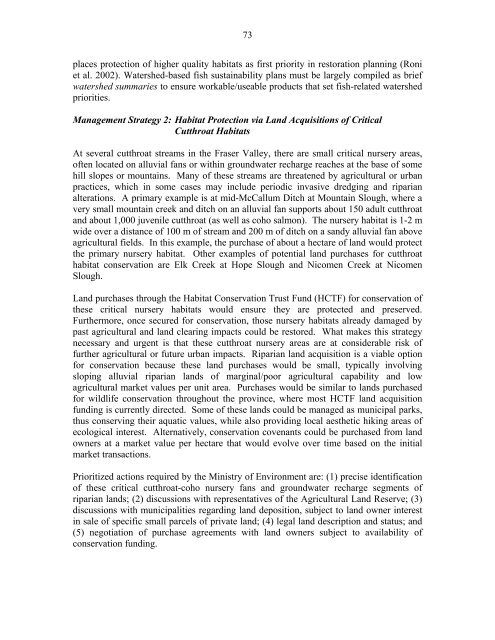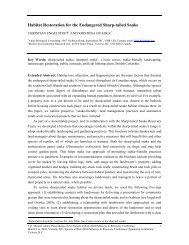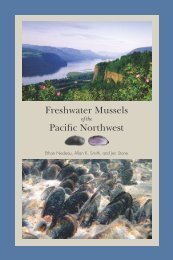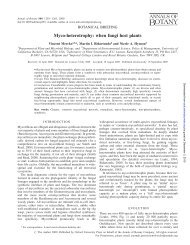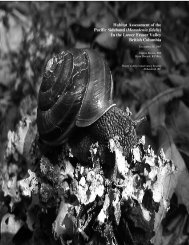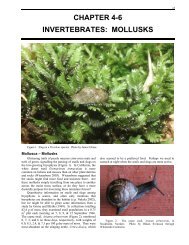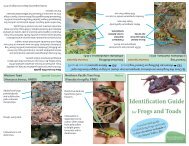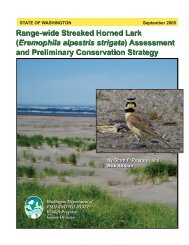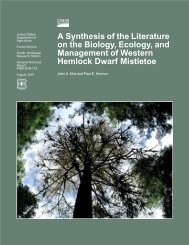Coastal Cutthroat Trout as Sentinels of Lower Mainland Watershed ...
Coastal Cutthroat Trout as Sentinels of Lower Mainland Watershed ...
Coastal Cutthroat Trout as Sentinels of Lower Mainland Watershed ...
Create successful ePaper yourself
Turn your PDF publications into a flip-book with our unique Google optimized e-Paper software.
73places protection <strong>of</strong> higher quality habitats <strong>as</strong> first priority in restoration planning (Roniet al. 2002). <strong>Watershed</strong>-b<strong>as</strong>ed fish sustainability plans must be largely compiled <strong>as</strong> briefwatershed summaries to ensure workable/useable products that set fish-related watershedpriorities.Management Strategy 2: Habitat Protection via Land Acquisitions <strong>of</strong> Critical<strong>Cutthroat</strong> HabitatsAt several cutthroat streams in the Fr<strong>as</strong>er Valley, there are small critical nursery are<strong>as</strong>,<strong>of</strong>ten located on alluvial fans or within groundwater recharge reaches at the b<strong>as</strong>e <strong>of</strong> somehill slopes or mountains. Many <strong>of</strong> these streams are threatened by agricultural or urbanpractices, which in some c<strong>as</strong>es may include periodic inv<strong>as</strong>ive dredging and riparianalterations. A primary example is at mid-McCallum Ditch at Mountain Slough, where avery small mountain creek and ditch on an alluvial fan supports about 150 adult cutthroatand about 1,000 juvenile cutthroat (<strong>as</strong> well <strong>as</strong> coho salmon). The nursery habitat is 1-2 mwide over a distance <strong>of</strong> 100 m <strong>of</strong> stream and 200 m <strong>of</strong> ditch on a sandy alluvial fan aboveagricultural fields. In this example, the purch<strong>as</strong>e <strong>of</strong> about a hectare <strong>of</strong> land would protectthe primary nursery habitat. Other examples <strong>of</strong> potential land purch<strong>as</strong>es for cutthroathabitat conservation are Elk Creek at Hope Slough and Nicomen Creek at NicomenSlough.Land purch<strong>as</strong>es through the Habitat Conservation Trust Fund (HCTF) for conservation <strong>of</strong>these critical nursery habitats would ensure they are protected and preserved.Furthermore, once secured for conservation, those nursery habitats already damaged byp<strong>as</strong>t agricultural and land clearing impacts could be restored. What makes this strategynecessary and urgent is that these cutthroat nursery are<strong>as</strong> are at considerable risk <strong>of</strong>further agricultural or future urban impacts. Riparian land acquisition is a viable optionfor conservation because these land purch<strong>as</strong>es would be small, typically involvingsloping alluvial riparian lands <strong>of</strong> marginal/poor agricultural capability and lowagricultural market values per unit area. Purch<strong>as</strong>es would be similar to lands purch<strong>as</strong>edfor wildlife conservation throughout the province, where most HCTF land acquisitionfunding is currently directed. Some <strong>of</strong> these lands could be managed <strong>as</strong> municipal parks,thus conserving their aquatic values, while also providing local aesthetic hiking are<strong>as</strong> <strong>of</strong>ecological interest. Alternatively, conservation covenants could be purch<strong>as</strong>ed from landowners at a market value per hectare that would evolve over time b<strong>as</strong>ed on the initialmarket transactions.Prioritized actions required by the Ministry <strong>of</strong> Environment are: (1) precise identification<strong>of</strong> these critical cutthroat-coho nursery fans and groundwater recharge segments <strong>of</strong>riparian lands; (2) discussions with representatives <strong>of</strong> the Agricultural Land Reserve; (3)discussions with municipalities regarding land deposition, subject to land owner interestin sale <strong>of</strong> specific small parcels <strong>of</strong> private land; (4) legal land description and status; and(5) negotiation <strong>of</strong> purch<strong>as</strong>e agreements with land owners subject to availability <strong>of</strong>conservation funding.


